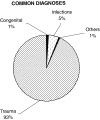Orthopaedic clinical officer program in Malawi: a model for providing orthopaedic care
- PMID: 18633684
- PMCID: PMC2584281
- DOI: 10.1007/s11999-008-0366-5
Orthopaedic clinical officer program in Malawi: a model for providing orthopaedic care
Abstract
Malawi has a population of about 13 million people, 85% of whom live in rural areas. The gross national income per capita is US$620, with 42% of the people living on less than US$1 per day. The government per capita expenditure on health is US$5. Malawi has 266 doctors, of whom only nine are orthopaedic surgeons. To address the severe shortage of doctors, Malawi relies heavily on paramedical officers to provide the bulk of healthcare. Specialized orthopaedic clinical officers have been trained since 1985 and are deployed primarily in rural district hospitals to manage 80% to 90% of the orthopaedic workload in Malawi. They are trained in conservative management of most common traumatic and nontraumatic musculoskeletal conditions. Since the program began, 117 orthopaedic clinical officers have been trained, of whom 82 are in clinical practice. In 2002, Malawi began a local orthopaedic postgraduate program with an intake of one to two candidates per year. However, orthopaedic clinical officers will continue to be needed for the foreseeable future. Orthopaedic clinical officer training is a cost-effective way of providing trained healthcare workers to meet the orthopaedic needs of a country with very few doctors and even fewer orthopaedic surgeons.
Figures



References
-
- Malawi Orthopaedic Project Report. 1985–1995. Blantyre, Malawi: Blantyre Print and Packaging; 1995.
-
- National Statistical Office (NSO) [Malawi], and ORC Macro. Malawi Demographic and Health Survey 2004. Calverton, Maryland: NSO and ORC Macro; 2005.
-
- Registered Health Professionals and Licensed Clinics. Medical Practitioners and Dentist Act. Zomba, Malawi: Government Printers; 2007.
-
- WHO Country Health System Fact Sheet 2006 – Malawi. World Health Organization Web site. Available at: http://www.who.int/countries/mwi/en. Accessed December 2007.
Publication types
MeSH terms
LinkOut - more resources
Full Text Sources
Medical

